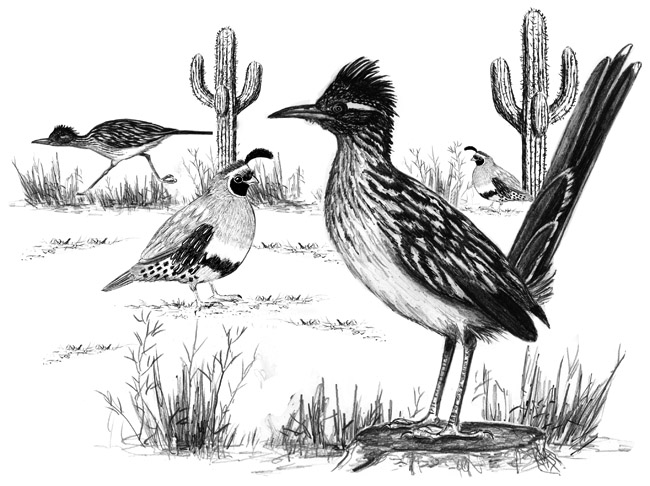
Western Birding II,
In case you were too wrapped up with the Patriots and missed last week’s column, let me fill you in. My son Casey and I are away birding in the Southwest. We started in San Diego, saw a bunch of coastal birds and then drove east. A stop in the Laguna Mountains produced a number of alpine birds, including a couple of striking Varied Thrushes. After eating several slices of apple pie in the yummy town of Julian, we left the mountains and headed for the desert. This is where I left off last week. If you are wondering what happened next, I’ll give you hint: we saw more birds.
Our first stop was in the desert town of Borrego Springs, which is the main town servicing California’s giant Anza-Borrego State Park. Before I begin, it’s important to note that January is not the greatest month for birding in this region. Better birding can be found in April and May, or later. So why did we go in January? I like birds, but I hate heat. Borrego Springs is in the desert for a reason. With summer temperatures reaching as high as 122°F, there is no way I’m going near this part of the world in any month except January. And if there were a colder month than January, I’d go then.
Our first stop was at the state park’s visitors center. To help shield the building from the scorching sun, the clever architects had it built underground. This makes it a little hard to find, but once we found it we almost didn’t leave. The center is surrounded by trails and wonderful gardens (well, desert gardens). I found several species of hummingbirds, Loggerhead Shrikes, Black-tailed Gnatcatchers, a Ladder-backed Woodpecker, a Phainopepla (look it up) and some Black-throated Sparrows. Casey tracked down a flock of Verdins (tiny yellow-faced birds), a Cactus Wren and some White-winged Doves. But most of his time was spent chasing a timid Black-tailed Jackrabbit. Casey is twenty-one, going on twelve. (I didn’t dare tell him to look for a Jack-a-lope.) And later we heard a Great Horned Owl. (No wonder the jackrabbit was so timid.)
The next day we continued east to one of the country’s most unusual bodies of water, the Salton Sea. At the turn of the last century, there was no such thing as the Salton Sea. But after a little irrigation malfunction, it became the largest inland body of water in California. According to the story, in 1905 engineers tried to divert water from the Colorado River to help irrigate the farms in California’s Imperial Valley. The plan worked well, too well. The powerful Colorado breached the engineered canals and for the next two years the river poured into the “Salton Sink,” a nearby valley that is well below sea level. By the time the officials figured out how to stop the flow, a 343-square-mile lake had been created. At first, the Salton Sea was a hit and resorts sprang up along its shore. Unfortunately, the main water source (the Colorado River) was shut off and now the lake is slowly drying up. The shoreline resorts have pretty much all rusted away, but the birds love the place. Over 400 different species have been seen around the Salton Sea, with some of the species numbering in the tens of thousands.
We spent most of our time at the Sonny Bono Wildlife Refuge (yes, the very same Sonny Bono of Sonny and Cher). The bird highlights included a flock of feisty Gamble’s Quail (these are the quintessential quail with that weird plume sticking out of tops of their heads), thousands of Snow Geese, dozens of White Pelicans, several Caspian Terns and one very fast Greater Roadrunner. As we drove back the hotel, I pulled the car over to check out a distant hawk and I heard Casey yell, “There’s a Burrowing Owl!” About five feet from where I had stopped, the tiny face of a lone owl peered out of its burrow. Casey and I were giddy with excitement, but the owl seemed less than pleased. Owls aren’t into the whole giddy thing.
(One word of caution about the Salton Sea: The sea and the area around it are ugly. Fish die-offs and the fertilizer used on the nearby industrial farms cause the area to stink. But if you like birds, hold your nose and go.)
After spending the night with the celebrities in Palm Springs, we stopped at the much more attractive Big Morongo Canyon Preserve. While we were checking out the birdfeeders near the entrance to the park, I noticed that a White-breasted Nuthatch had gotten itself into trouble. One of the bird’s feet had become tangled in a small chain on the side of a tree. I hopped the fence to help, but the bird was a bit out of my reach. At that moment the caretaker burst out of his house (actually a trailer, but house sounds better) yelling, “What are you doing?” (I almost started laughing because the guy looked and sounded like an old prospector.) I explained the problem and soon his son appeared (a slightly younger looking prospector) with a ladder and some tools. After a bit of work, the nuthatch was on its way, with a sore foot and a very exciting story to tell. I really enjoyed birding the Big Morongo Canyon Preserve, but one place I don’t care for is the nearby Joshua Tree National Park. Oh, sure, the place is fascinating, but I’ve been there twice and have yet to see a single bird. So, we left the park and headed for Tucson, AZ, where birding is really good, even in January. I’ll report on Tucson next week. Sadly, this will be our last stop on our fun adventure. We are not heading home because we are tired of birding, but because I’m just about out of money and have to get back to work. Stupid work.